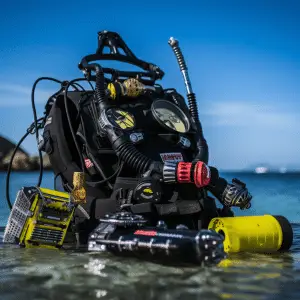Importance of Proper Scuba Diving Equipment
Scuba diving needs the right equipment to be safe and enjoyable. A mask for clear vision, a regulator for air, a wetsuit for warmth, buoyancy control to stay stable, and dive computers for data. These all help create a successful dive.
Not all gear is made equal. Investing in more reliable brands improves safety, longevity, and value.
Did you know? PADI’s study found that rental gear increases the risk of accidents. So, having personal gear is essential for underwater adventures.
Essential Gear for Scuba Diving
Scuba diving requires essential gear to ensure a safe and enjoyable experience. Here are the must-haves:
- Mask: Seals the nose and eyes, so you can see beneath the waves.
- Snorkel: For breathing while your face is submerged.
- Fins: AKA flippers. Propel you and reduce leg fatigue.
- BCD: Inflatable jacket helps you ascend and descend effortlessly.
- Regulator: Delivers air from tank to you, for smooth breathing.
Other items:
- Wetsuit or Drysuit: Protects and insulates depending on water temperature.
- Dive Computer: Monitors dive time, depth, and other data for safety.
- Dive Knife: Cut through lines or help self-defense with marine life.
Invest in quality gear that fits snugly and meets safety standards. Did you know? 7 million people worldwide participated in scuba diving in 2020, according to Diver Magazine.
Safety Equipment for Scuba Diving

Scuba diving, an exciting underwater experience, needs essential safety equipment for divers to remain safe. Let’s look at what you need:
- Dive mask: Allows divers to see with an air pocket around their eyes.
- Snorkel: Enables divers to breathe on the surface without wasting air from the tank.
- Wetsuit or drysuit: Protects against hypothermia and jellyfish stings.
- BCD (buoyancy control device): Adjusts the volume of air inside it to help divers control buoyancy.
- Dive computer: Monitors dive info like depth and time, reducing the risk of decompression sickness.
Other important safety items are a weight belt, regulator, and compass. They make sure you have a safe and enjoyable experience. Each piece plays a vital role. The mask ensures clear vision, the snorkel conserves air, the suit keeps you warm, the BCD helps you move, and the computer gives you real-time data.
Scuba diving is amazing, but safety equipment is essential. Prioritize safety to maximize your fun. Be sure to keep your gear in good shape – it’s all about survival!
Maintenance and Care of Scuba Diving Equipment

For proper scuba gear care and maintenance, it’s key to stick to certain guidelines. These practices ensure your gear’s performance and longevity, letting you enjoy underwater adventures to the full.
- Rinse with Fresh H2O: After each dive, give equipment a thorough freshwater rinse to remove salt and debris – this includes your wetsuit, BCD, dive computer, regulators and mask. No harsh detergents or chemicals though – they can damage materials.
- Store in Cool, Dry Place: To avoid mold, mildew and corrosion, make sure to air-dry gear before stowing away in a cool, dry place – away from sunlight.
- Regularly Inspect and Service: Often inspect all components for signs of wear or damage. Check hoses for cracks/leaks, straps on fins/mask for fraying and O-rings for good condition. Have regs serviced by a pro once a year.
- Follow Manufacturer Guidelines: Read and follow manufacturer instructions carefully – this will help avoid gear damage and ensure longevity.
Plus, be gentle when transporting gear to avoid accidental damage. Also, don’t leave exposed to extreme temps for too long, as this can affect performance.
Pro Tip: Invest in protective cases/bags for added protection when traveling or storing.
With these maintenance tips and proper care, you can keep your scuba gear in great shape and keep enjoying safe, fun underwater experiences.
